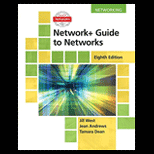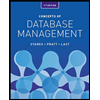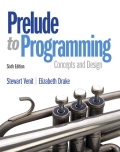E 10 3 9 4 9. 1 F J 7 G H 3 7 1 6. K L 1) What is the lowest cost path to go from vertex A to vertex L? (Your answer should be a comma separated list of vertices starting with A and ending with L which represents the lowest cost path between the vertices. Example: A, Z, S, Q, L) 2) What is the total cost of the lowest cost path to go from vertex A to vertex L? (Your answer should just be a number) 4.
E 10 3 9 4 9. 1 F J 7 G H 3 7 1 6. K L 1) What is the lowest cost path to go from vertex A to vertex L? (Your answer should be a comma separated list of vertices starting with A and ending with L which represents the lowest cost path between the vertices. Example: A, Z, S, Q, L) 2) What is the total cost of the lowest cost path to go from vertex A to vertex L? (Your answer should just be a number) 4.
Computer Networking: A Top-Down Approach (7th Edition)
7th Edition
ISBN:9780133594140
Author:James Kurose, Keith Ross
Publisher:James Kurose, Keith Ross
Chapter1: Computer Networks And The Internet
Section: Chapter Questions
Problem R1RQ: What is the difference between a host and an end system? List several different types of end...
Related questions
Question
100%
![## Shortest Path Problem Using Dijkstra's Algorithm
Use Dijkstra's algorithm to determine the shortest paths starting from vertex A to all other vertices, then answer the 2 questions shown below the graph.
### Graph Description
The graph contains the following vertices and edges with their respective weights (costs):
- Vertex A is connected to:
- Vertex D (cost: 4)
- Vertex F (cost: 6)
- Vertex K (cost: 7)
- Vertex B is connected to:
- Vertex D (cost: 8)
- Vertex C (cost: 2)
- Vertex C is connected to:
- Vertex E (cost: 5)
- Vertex D is connected to:
- Vertex E (cost: 9)
- Vertex G (cost: 3)
- Vertex E is connected to:
- Vertex H (cost: 4)
- Vertex I (cost: 9)
- Vertex C (cost: 5)
- Vertex F is connected to:
- Vertex G (cost: 1)
- Vertex K (cost: 7)
- Vertex G is connected to:
- Vertex H (cost: 6)
- Vertex D (cost: 3)
- Vertex F (cost: 1)
- Vertex H is connected to:
- Vertex I (cost: 3)
- Vertex K (cost: 4)
- Vertex I is connected to:
- Vertex J (cost: 2)
- Vertex J is connected to:
- Vertex L (cost: 1)
### Questions
1. What is the lowest cost path to go from vertex A to vertex L?
(Your answer should be a comma-separated list of vertices starting with A and ending with L which represents the lowest cost path between the vertices. Example: A, Z, S, Q, L)
**Answer:** [_____, _____, _____, _____, _____, _____]
2. What is the total cost of the lowest cost path to go from vertex A to vertex L?
(Your answer should just be a number)
**Answer:** [________]](/v2/_next/image?url=https%3A%2F%2Fcontent.bartleby.com%2Fqna-images%2Fquestion%2F8a000fe0-342d-4f80-8d89-1b56a9b64020%2F01d7d49c-7f07-45bf-91ef-795fae380cd8%2F1j4os19_processed.jpeg&w=3840&q=75)
Transcribed Image Text:## Shortest Path Problem Using Dijkstra's Algorithm
Use Dijkstra's algorithm to determine the shortest paths starting from vertex A to all other vertices, then answer the 2 questions shown below the graph.
### Graph Description
The graph contains the following vertices and edges with their respective weights (costs):
- Vertex A is connected to:
- Vertex D (cost: 4)
- Vertex F (cost: 6)
- Vertex K (cost: 7)
- Vertex B is connected to:
- Vertex D (cost: 8)
- Vertex C (cost: 2)
- Vertex C is connected to:
- Vertex E (cost: 5)
- Vertex D is connected to:
- Vertex E (cost: 9)
- Vertex G (cost: 3)
- Vertex E is connected to:
- Vertex H (cost: 4)
- Vertex I (cost: 9)
- Vertex C (cost: 5)
- Vertex F is connected to:
- Vertex G (cost: 1)
- Vertex K (cost: 7)
- Vertex G is connected to:
- Vertex H (cost: 6)
- Vertex D (cost: 3)
- Vertex F (cost: 1)
- Vertex H is connected to:
- Vertex I (cost: 3)
- Vertex K (cost: 4)
- Vertex I is connected to:
- Vertex J (cost: 2)
- Vertex J is connected to:
- Vertex L (cost: 1)
### Questions
1. What is the lowest cost path to go from vertex A to vertex L?
(Your answer should be a comma-separated list of vertices starting with A and ending with L which represents the lowest cost path between the vertices. Example: A, Z, S, Q, L)
**Answer:** [_____, _____, _____, _____, _____, _____]
2. What is the total cost of the lowest cost path to go from vertex A to vertex L?
(Your answer should just be a number)
**Answer:** [________]
Expert Solution
This question has been solved!
Explore an expertly crafted, step-by-step solution for a thorough understanding of key concepts.
This is a popular solution!
Trending now
This is a popular solution!
Step by step
Solved in 2 steps

Recommended textbooks for you

Computer Networking: A Top-Down Approach (7th Edi…
Computer Engineering
ISBN:
9780133594140
Author:
James Kurose, Keith Ross
Publisher:
PEARSON

Computer Organization and Design MIPS Edition, Fi…
Computer Engineering
ISBN:
9780124077263
Author:
David A. Patterson, John L. Hennessy
Publisher:
Elsevier Science

Network+ Guide to Networks (MindTap Course List)
Computer Engineering
ISBN:
9781337569330
Author:
Jill West, Tamara Dean, Jean Andrews
Publisher:
Cengage Learning

Computer Networking: A Top-Down Approach (7th Edi…
Computer Engineering
ISBN:
9780133594140
Author:
James Kurose, Keith Ross
Publisher:
PEARSON

Computer Organization and Design MIPS Edition, Fi…
Computer Engineering
ISBN:
9780124077263
Author:
David A. Patterson, John L. Hennessy
Publisher:
Elsevier Science

Network+ Guide to Networks (MindTap Course List)
Computer Engineering
ISBN:
9781337569330
Author:
Jill West, Tamara Dean, Jean Andrews
Publisher:
Cengage Learning

Concepts of Database Management
Computer Engineering
ISBN:
9781337093422
Author:
Joy L. Starks, Philip J. Pratt, Mary Z. Last
Publisher:
Cengage Learning

Prelude to Programming
Computer Engineering
ISBN:
9780133750423
Author:
VENIT, Stewart
Publisher:
Pearson Education

Sc Business Data Communications and Networking, T…
Computer Engineering
ISBN:
9781119368830
Author:
FITZGERALD
Publisher:
WILEY